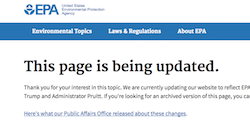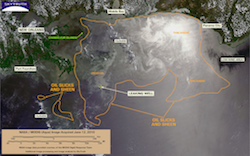SEJournal Online is the digital news magazine of the Society of Environmental Journalists. Learn more about SEJournal Online, including submission, subscription and advertising information.
WatchDog: Federal Agencies Scrub Climate Info; plus Libel Suit, Spill Catcher, Surveillance & Water Data
By Joseph A. Davis, WatchDog TipSheet Editor
1. Remember the “Memory Hole”? It’s Opening at EPA
In George Orwell’s dystopian novel “1984,” workers use a “memory hole” to achieve permanent disappearance of politically inconvenient writings and documents. Some skeptics thought it excessively paranoid when, after the 2016 election, a group of truth-workers and academics began copying online government documents and data about climate science and related topics.
 |
| An EPA web page on climate removed for revision. Image: EPA.gov |
It turns out it wasn’t. Federal environmental agencies under President Donald Trump have begun purging from the web information about things that they find politically inconvenient, like climate, animal cruelty and workplace health and safety violations.
In one of those “Friday news dumps” on April 28, the U.S. Environmental Protection Agency announced that many climate pages on its website had been removed for revision. EPA Administrator Scott Pruitt has expressed doubt about long-established climate science as he pursues a deregulatory agenda sought by fossil fuel industries. As of late May, EPA has not replaced the disappeared pages.
The scrubbing includes general audience explainers, raw data, finished official reports and other information formerly online. And it spreads beyond the EPA to include agencies like the departments of Interior, Agriculture and State, as well as the Occupational Safety and Health Administration. Reporter Juliet Eilperin outlined the growing scope of the memory hole in a May 14 piece for the Washington Post.
The censorship does seem to focus especially on climate change. The Interior Department removed web pages describing the melting of Montana glaciers due to climate warming, sea-level rise in Florida and the mounting number of wildfires climate change is bringing.
Former EPA Administrator Gina McCarthy blasted the censorship. "This is unprecedented in terms of the scope of information that's been taken down. Information that's public information. People have a right to be able to access it, and no president has ever done this before," McCarthy told MSNBC host Rachel Maddow.
Scientists promptly pointed out that the information taken down from the EPA site was accurate. EPA said that it had posted the information that had been removed on an archive site, but the site was hard to get at and its contents were incomplete.
Meanwhile, some open-government groups sought to trigger a provision of the Freedom of Information Act to force EPA to restore the disappeared data. That is the so-called “Beetlejuice provision” that requires records FOIAd three times to be posted online. It may be academic, since Chicago Mayor Rahm Emanuel (former President Barack Obama’s ex chief of staff) made it his job to post all the missing pages on the city’s site.
2. Murray Energy Sues New York Times for Libel
The Murray Energy Co. is making news by suing the New York Times for libel, an unusual maneuver that has rarely succeeded against the paper in the past. Murray, one of the largest U.S. coal companies, charged that a Times editorial falsely accused its founder, Robert Murray, of lying about the cause of a fatal 2007 mine incident and the company’s compliance with safety rules. The Times’ Public Editor, Liz Spayd, dismissed the suit as a company effort to “grab a few headlines.”
3. SkyTruth Catches Oil Firms Hiding Big Spills
 |
| Satellite imagery of the Deepwater Horizon oil spill, June 2010. Image: SkyTruth |
These days, cutting-edge investigative journalism uses satellites. An organization called SkyTruth has been doing this for years — since before the 2010 Deepwater Horizon mega-spill in the Gulf of Mexico (which it covered).
That’s especially helpful for oil spill journalists left hampered when the U.S Coast Guard defanged its National Response Center, or NRC, online database (which wasn’t that accurate or timely to start with).
SkyTruth, founded by maven John Amos, uses publicly available satellite images to investigate a range of environmental problems. The difference is that SkyTruth tells the public what it finds.
Most recently, SkyTruth worked with some Louisiana environmental groups to compare the number and volume of spills that Gulf drillers reported to the Coast Guard’s NRC with the actual measurements from remote sensing. The companies dramatically underreported their spills.
4. What You Need To Know About Electronic Surveillance
Until recently, many journalists thought that they didn’t have to worry about electronic surveillance unless they were handling national security leaks à la Glenn Greenwald. Today, it is kind of a status symbol to include your public PGP key (one method for encrypting messages) with your phone number and email.
Fortunately, the Reporters Committee for Freedom of the Press has just issued a report entitled “Electronic Communications Surveillance: What Journalists and Media Organizations Need to Know.” It tells journalists a lot about what their rights are — and how to communicate safely.
5. Bureau of Reclamation Offers Online Water Data
Some environmental journalists who are data geeks may rejoice to hear news of an online interactive data offering on Bureau of Reclamation water projects.
BuRec projects are important if you live in the 17 western states. While BuRec dams, reservoirs and powerplants are only a fraction of the national total, they loom large in that region. The information offered by the new Reclamation Water Information System does not cover safety, but does include lots of quantitative historical data about things like releases. If you want to look at how climate change might be affecting water supply, the database may offer some insights.
It’s still in its pilot phase, but is already full of data and easy to use. The announcement is here and the query page is here.
6. Trump Asked Comey To Jail Reporters for Leaking
One overlooked facet of the bombshell memo by fired FBI director James Comey about President Trump’s bid to shut down the Russia investigation was a plea by Trump that Comey jail some reporters for reporting leaked classified information.
The news was not received well. The Reporters Committee for Freedom of the Press fired off a statement May 16 saying, “The comments attributed to President Trump cross a dangerous line. But no president gets to jail journalists.” Other journalism groups, such as the Freedom of the Press Foundation, echoed the outrage.













 Advertisement
Advertisement 



